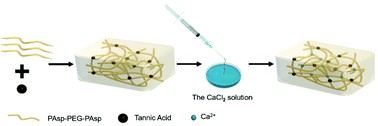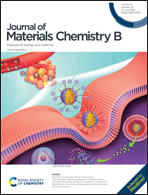Dual crosslinking hydrogels with tunable injectability and stability for bone repair†
Abstract
As an ideal biomaterial, the injectable dual crosslinking hydrogel can fill irregular shaped defects for treating bone defects. Despite advances in the fabrication of injectable dual crosslinking hydrogels, current methods pose several limitations in the gelation process, such as unadjustable injectability, materials loss after injection and the employment of nonphysiological environments. A more rational designed hydrogel should be shear-thinning and self-healing quickly after injection, which requires a reversible noncovalent or dynamic covalent interaction. Besides, the improved mechanical properties and stability can be achieved in vivo. In this present research study, inspired by a high Ca2+ concentration in the bone defect sites, a strategy combining hydrogen bonds and ion coordination to construct dual crosslinking hydrogels is developed. The prefabricated gel precursors based on hydrogen bonds of synthetic triblock poly(aspartic acid)–poly(ethylene glycol)–poly(aspartic acid) copolymers and tannic acid can be injected smoothly and recover rapidly to the initial state after injection. In addition, the hydrogel network can be crosslinked more tightly through the –COOH–Ca2+ chelation, which results in reinforced mechanical properties and stability. The developed injectable dual crosslinking hydrogels will provide a design idea for the secondary crosslinking of injectable hydrogels in vivo, especially in the bone repair sites.



 Please wait while we load your content...
Please wait while we load your content...